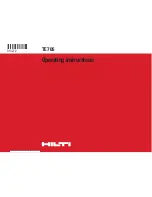
8
5.0
Set-Up and Assembly
Inspect contents of crate for shipping damage.
Report any damage immediately to your distributor
and shipping agent. Do not discard any shipping
material until drill press is assembled and running
properly.
Remove any fasteners holding drill press to pallet.
Lift drill press with forklift or hoist with straps.
(Note: Lifting point is beneath head and next to
column.) Make sure coolant hose, handles, etc. are
clear of forks or straps when lifting.
Lifting
equipment must be properly rated for weight of
drill press.
Locate the machine on a solid, level floor,
preferably concrete. Area should have good
overhead lighting and ventilation. (Refer to OSHA
regulations for specific information about using drill
presses in industrial environments.) The drill press
should be level and rest solidly on floor. Place
shims below base as needed to achieve level.
Exposed metal surfaces have been given a
protective coating. Remove this with a soft cloth
and a cleaner-degreaser or kerosene. Do not use
gasoline, paint thinner or acetone, as these may
damage painted surfaces. Do not use an abrasive
pad, as it may scratch polished surfaces.
Coat all machined surfaces with a light coat of oil to
inhibit rust.
5.1
Securing base
It is highly recommended that the drill press be
secured to floor. The base of the drill press has
four mounting slots; see Figure 4-1. When securing
base to floor, apply even torque to the fasteners to
prevent distortion of base.
5.2
Raising head
The drill press head is lowered on the column for
crating and transportation, and is supported by a
2x4 wood block on the table. Before operating drill
press, the head must be raised to operational level,
as follows.
1. Loosen two head locking nuts (Figure 5-1) by
turning counterclockwise.
2. Grasp the head and turn it slightly from side to
side to loosen the rust prevention solution on
column.
3. Loosen table lock by placing handle on
crankshaft (see A, Figure 8-2) and rotating
handle counterclockwise.
4. Raise table by placing handle on crankshaft (B
or C, Figure 8-2) and rotating clockwise.
5. Continue raising head and 2x4 until top of
pulley cover and column are flush. Use a
ladder to observe the column through top of
pulley cover.
6. Securely tighten the two head locking nuts
(Figure 5-1). The 2x4 can now be safely
removed.
To lower head, reverse the steps above.
Never loosen head locking
nuts without supporting head.
Figure 5-1
6.0
Electrical Connections
Electrical connections must
be made by a qualified electrician in
compliance with all relevant codes. This
machine must be properly grounded to help
prevent electrical shock and possible fatal
injury.
The
JDP-20EVS-110
Drill Press is pre-wired for 1-
phase,
115-volt
. It is provided with an electrical
plug. See
sect. 6.2
.
The
JDP-20EVST-230
is pre-wired for 3-phase,
230-volt.
It is not provided with an electrical plug;
you may either attach a proper UL-listed plug, or
“hardwire” the machine directly to a service panel.
The machine can also be run on 1-phase power
(230-volt). See
sect. 6.2.
The
JDP-20EVST-460
is pre-wired for 3-phase,
460-volt only.
It is not provided with an electrical
plug; you may either attach a proper UL-listed plug,
or “hardwire” the machine directly to a service
panel. See
sect. 6.2.
6.1
Electrical box access
Push latch button and rotate latch counter-
clockwise to open. Use the provided key to lock the
electrical box to prevent unauthorized entry.
Summary of Contents for JDP-20EVS-110
Page 16: ...16 12 1 1 JDP 20EVS 110 Top Head Assembly Exploded View ...
Page 19: ...19 12 2 1 JDP 20EVS 110 Table and Base Assembly Exploded View ...
Page 25: ...25 12 5 1 JDP 20EVST 230 460 Top Head Assembly Exploded View ...
Page 28: ...28 12 6 1 JDP 20EVST 230 460 Base and Table Assembly Exploded View ...
Page 32: ...32 13 2 JDP 20EVST 230 wiring diagram ...
Page 33: ...33 13 3 JDP 20EVST 460 wiring diagram ...
Page 35: ...35 This page intentionally left blank ...
Page 36: ...36 427 New Sanford Road LaVergne Tennessee 37086 Phone 800 274 6848 www jettools com ...









































